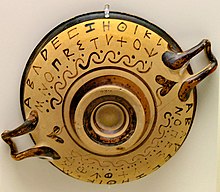|
Theta
Theta (UK: /ˈθiːtə/, US: /ˈθeɪtə/) uppercase Θ or ϴ; lowercase θ[note 1] or ϑ; Ancient Greek: θῆτα thē̂ta [tʰɛ̂ːta]; Modern: θήτα thī́ta [ˈθita]) is the eighth letter of the Greek alphabet, derived from the Phoenician letter Teth Greek In Ancient Greek, θ represented the aspirated voiceless dental plosive IPA: [t̪ʰ], but in Modern Greek it represents the voiceless dental fricative IPA: [θ].
FormsIn its archaic form, θ was written as a cross within a circle (as in the Etruscan  The cursive form ϑ was retained by Unicode as U+03D1 ϑ GREEK THETA SYMBOL, separate from U+03B8 θ GREEK SMALL LETTER THETA. (There is also U+03F4 ϴ GREEK CAPITAL THETA SYMBOL.) For the purpose of writing Greek text, the two can be font variants of a single character, but θ and ϑ are also used as distinct symbols in technical and mathematical contexts. Extensive lists of examples follow below at Mathematics and Science. U+03D1 ϑ GREEK THETA SYMBOL (script theta) is also common in biblical and theological usage e.g. πρόϑεσις (prothesis) instead of πρόθεσις (means placing in public or laying out a corpse). LatinIn Latin script used for the Gaulish language, theta inspired the tau gallicum (Ꟈ ꟈ). The phonetic value of the tau gallicum is thought to have been [t͡s].[1] In addition, multiple modern languages written in Latin script use Latin theta. CyrillicThe early Cyrillic letter fita (Ѳ, ѳ) developed from θ. This letter existed in the Russian alphabet until the 1918 Russian orthography reform. International Phonetic AlphabetIn the International Phonetic Alphabet (IPA), [θ] represents the voiceless dental fricative, as in thick or thin. It does not represent the consonant in the, which is the voiced dental fricative counterpart, represented in the IPA by [ð] (cf. Eth). A similar-looking lower-case symbol, [ɵ], which is called barred o, is the IPA symbol for the close-mid central rounded vowel. Mathematics and scienceLower caseThe lowercase letter θ is used as a symbol for:
Upper caseThe uppercase letter Θ is used as a symbol for:
Symbolism In ancient times, Tau was used as a symbol for life or resurrection, whereas the eighth letter of the Greek alphabet (ninth in the archaic form anciently used for numeration), theta, was considered the symbol of death.[3] A quotation attributed to the ancient Roman author Ennius (though possibly spuriously) said of it: "oh, theta, a letter much unluckier than the others".[4] According to Porphyry of Tyros, the Egyptians used an X within a circle as a symbol of the soul; having a value of nine, it was used as a symbol for Ennead. Johannes Lydus says that the Egyptians used a symbol for Kosmos in the form of theta, with a fiery circle representing the world, and a snake spanning the middle representing Agathos Daimon (literally: good spirit).[5] AbbreviationIn classical Athens, it was used as an abbreviation for the Greek θάνατος (Thanatos, "death") and as it vaguely resembles a human skull,[5] theta was used as a warning symbol of death, in the same way that skull and crossbones are used in modern times.[5] It survives on potsherds used by Athenians when voting for the death penalty.[5] Petrus de Dacia in a document from 1291 relates the idea that theta was used to brand criminals as empty ciphers, and the branding rod was affixed to the crossbar spanning the circle.[6] For this reason, the use of the number 9 was sometimes avoided where the connotation was felt to be unlucky—the mint marks of some Late Imperial Roman coins famously have the sum ΔΕ or ΕΔ (delta and epsilon, that is 4 and 5) substituted as a euphemism where a Θ (9) would otherwise be expected. Unicode
See also
Notes and referencesNotes
References
|

